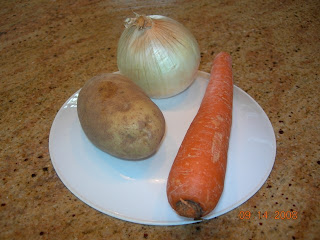


Week 2: Mise en place and Stock:
(and knife skills practice)
In cooking everything has a place and must be in the right place before you start cooking. I guess that's why Rachel Ray always gathers up her giant armful of stuff and brings it to the counter before she starts cooking. I always just started cooking and then would run around the kitchen grabbing stuff as I cooked, hoping I had the ingredients somewhere. I think back on all the times I rummaged through the spices in the cabinet looking for allspice or cloves or something I don't use that often, or even worse started frying the onions before noticing I was out of garlic and green peppers. Oh well, no more of that syle of cooking. Tonight when I made dinner I made sure every last thing was on the counter, even the fresh basil out of the garden which I usually send Steve out to get at the last minute. It really was more efficient but it will take time to get into the habit. Makes sense in a commercial kitchen, though. With our class of 12-13 students it would not be a pretty sight to see us all scurrying around constantly grabbing stuff as we went.
We also made 3 types of stock: brown stock, white stock, and court bouillion. Stock is very important, very tedious, and very slow. Translation: boring..... So just remember, don't use Swanson's broth. It has salt in it and real stock does not have salt it in. Real chefs use real stock made by using veal (beef, chicken) bones, lots of mire poix (onions, carrots, celery), fresh herbs, wine and slow cooking at a bubble, not a simmer.
Clarified butter is also important for professional cooking. Instead of just melting the butter and living with the cloudy color, we learned that by melting it and heating it the milk solids separate and can be skimmed off the top (and left on the bottom), yielding a clear, golden substance that has a higher smoke point than whole butter. Who knew?
And, of course we practiced knife skills. We were told to get a potato, onion, and carrot and then told to peel them all, julienne the potato (2 inch long, 1/4 x 1/4) dice the onion (1/4 " cubes), and brunoise the carrot (turn it into 1/8" cubes). We were timed and after what seemed like no time at all, told time was up. We had been given 12 minutes. Chef told us during our final test we would have 5 minutes to complete these tasks! Yikes! I had diced the onion, not touched the potato, and brunoised about the half the carrot. I tried to practice at home as you can see from the above photo. I julienned the potato, brunoised part of the carrot, but didn't touch the onion.
Much more practice is needed.
Finally, notice in the photo, a mandoline. I had to learn how to use this scary piece of equipment. I see chefs using them on Iron Chef and always worry they are about to slice their hand along with the potatoes, apples, radishes, etc. and I feel very uncomfortable. Turns out you're supposed to always use the guard. We were told to get comfortable with the mandoline because we'd be using it a lot (and it makes neat waffle fries like Chick Fil A.) I decided to take the plunge and buy one so I wouldn't look like a total idiot if I had to slice paper thin cucumbers one day. In one of the photos, notice the waffle cut potatoes. We had delicious, very crisp potatoes tonight and everyone was very impressed. Steve used the mandoline more than me and kept slicing different types of potatoes. It was actually fun and I look forward to using it.
It can sure julienne potatoes a lot better than me.
I signed up to volunteer at the Jazz on the Boulevard event next week so I will be out there in public. Hope nobody I know wanders by and recognizes me (or a real chef asks me to do something I don't know how to do).
 RSS Feed
RSS Feed Twitter
Twitter


 8:17 PM
8:17 PM
 Unknown
Unknown












0 comments:
Post a Comment